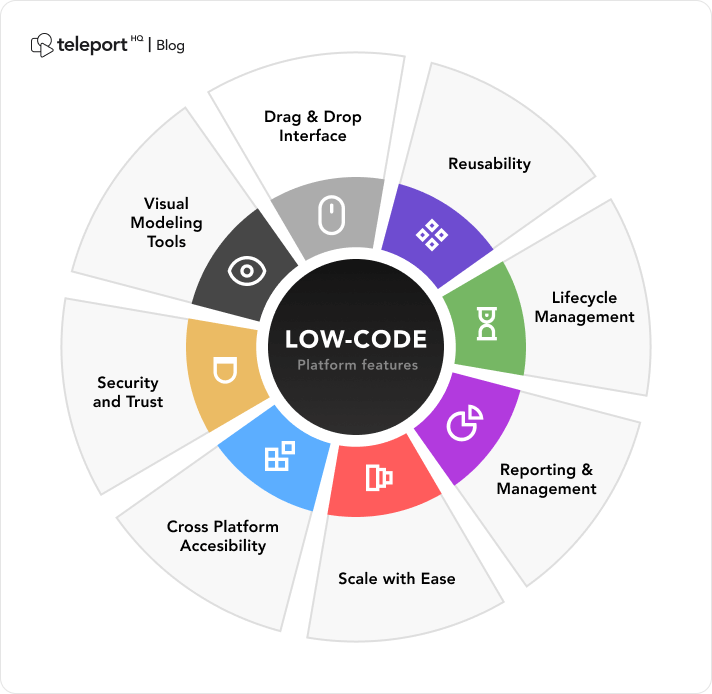Great Ideas On Deciding On Low-Code Platform Sites
Wiki Article
The Advantages Of Developing Low-Code To Speed Up Development
Visual Development Environment :
Drag-and-Drop Interfaces: Low-code platforms provide visual tools for designing applications. Drag-anddrop components enable developers to quickly build applications, without needing to write code.
Pre-built components and templates Low-code platforms have pre-built components and templates, which allow developers to rapidly prototype and build applications.
Reducing Coding requirements
Automated Code Generating: Low-code platform automatically generates code beneath based on the visual models that developers create. This eliminates the need to manually code, and speeds up development.
Reusable Components : Developers can reuse components in different projects, thereby reducing the amount of time they spend writing and testing codes.
Streamlined collaboration:
Low-code platform tools typically include testing, versions control deployment. This facilitates seamless collaboration between teams.
Development by citizens: Using intuitive interfaces and reducing bottlenecks often caused by the insufficient availability of developers, business users as well as non-developers can help in the development of applications.
Rapid prototyping and iteration
Fast Prototyping Developers can quickly create prototypes of ideas that can be validated and feedback gathered, resulting to faster iteration.
Simple Modifications - The visually appealing nature of low-code development permits for simpler updates and modifications that speed up the refining of applications based on user feedback.
Pre-built Integrations:
API Integrations: Low-code platforms typically come with pre-built connectors for popular services and APIs which reduce the time needed to integrate external systems.
Data Integration: The built-in tools make it easier for connecting to databases and other sources, accelerating the process of development.
Deployment, scaling and deployment
One-Click Embedded Deployment: Many low-code platforms have one-click deployment options, significantly decreasing the amount of amount of time and effort required to deploy apps.
Cloud-Based Solution: Cloud based low code platforms are capable of handling the management of infrastructure and scale. This allows developers to concentrate more on the application logic, functionality and features, rather than deployment logistics.
The main advantage of low code application development, in terms of speed, is its capacity to automatize and simplify many aspects of the development process. This allows rapid delivery of software and quicker adaptations to changing needs. Follow the top more helpful hints on Low-code Platform for application development for more examples including cross platform mobile dev, paas service, driver jdbc, rad application development, build a docker container, push notifications android, ms azure sql, rapid app development, low code development platforms, software for app development and more.

Benefits Low-Code Applications In Governance And Safety
Low-code applications offer a number of advantages when it comes to governance and security, which are crucial to ensure that applications are safe and secure. They also ensure that they are well-managed throughout their lifecycle. Here are some of the major advantages:
Unified Manage Console: Lowcode platforms typically have a management console which allows administrators to manage and supervise applications.
Role-Based Access Control RBAC: These platforms are equipped with powerful role-based controls that permit administrators to set access rules. It makes sure that only users with authorization can alter or gain access to specific areas of the application.
Compliance and Regulatory Adherence
A lot of low-code platforms have built-in compliance functions. These are designed to ensure that apps comply with industry standards (e.g. GDPR, HIPAA). They provide frameworks and tools to help ensure that applications meet these requirements.
Audit trails and logging Complete audit trails and logging are often combined. This lets organizations keep track of changes and access as well as ensure conformity with internal rules as well as external regulations.
Enhance Security Measures
Data Encryption Low-code platforms typically have built-in encryption for data in transit and in rest, securing sensitive data.
Security Certifications: A lot of providers of low-code software have security certifications like ISO 27001 or SOC 2 to prove that they adhere to high standards. These certifications provide additional assurances to users.
Automated security updates
Regular patches and updates Low-code platforms can handle the majority of security patches and updates in a way. They ensure that apps are secure from the latest attacks without requiring developers to intervene manually.
Security Monitoring: Continuous security monitoring tools can be used to send real-time notifications and information on security concerns.
Data Governance
Data Access Policies These systems allow organisations to create data access rules and enforce the policies, making sure that data is available only to users who are authorized. They also make sure that the data is used correctly.
Data Masking and Anonymization: Built-in tools to mask and anonymize data safeguard sensitive data, particularly in testing and development environments.
Consistent Application Management:
Development and deployment Pipelines: Low code platforms offer integrated development and deploy pipelines that include security inspections. These ensure that security is maintained throughout the entire lifecycle of the application.
Version Control: A unified version control system is used to control changes, allowing any changes that are made to an application to be monitored. If required, these can be reverted and the integrity of the application maintained.
User Authentication & Authorization
Single Sign On (SSO): Single sign-on and other advanced authentication methods reduces the burden of managing users and increases security.
Multi-Factor Authentication (MFA): Many platforms provide built-in support to multi-factor authentication, adding an additional layer of security to access applications.
Policy Enforcement Monitoring and Compliance:
Low-code platforms usually come already pre-defined with templates for policies to assist organizations in implementing governance and security policies quickly.
Compliance Monitoring Tools: They provide continuous monitoring and report on the status of compliance. This makes it easier to identify potential issues and take action to address them.
Integration with Existing Security Infrastructure
Seamless Integration: Platforms using low-code have been built to integrate seamlessly with the existing tools and infrastructure like SIEM (Security Information and Event Management solutions) and firewalls.
API Security: Built in API security features help protect information, guarantee integrity of the application and provide secure integrations.
Best practices and training:
Numerous platforms provide guides and best practice for developing secure applications. They assist non-developers to adhere to security standards.
Security Training Some low-code providers offer security training and resources to users to educate them on how to create and maintain secure applications.
The security and governance features of low-code apps ensure they are managed and built in a safe and secure manner. These platforms comprise the frameworks and tools needed to manage and oversee the process of developing applications, and protect sensitive data while maintaining the compliance of regulations and enforcing rules. Have a look at the most popular Enterprise application development with Low-code Platform hints for more info including app development platform, sso azure, azure sql databases, microsoft azure sql, microsoft azure sql, multiplatform mobile app development, azure sql, rad development, azure sql, develop web application and more.

Low-Code App Development Offers Numerous Advantages When It Comes To Collaboration And Workflow
It's a great option for businesses that want to improve team efficiency by streamlining processes and improving collaboration. Here are the key benefits: Improved Cross-Functional Collaboration:
Unified Development Environment: Low-code platforms provide a single, unified environment in which all team members such as business analysts, developers designers, and other stakeholders, can collaborate effectively. They remove silos while encouraging greater communication.
Visual Development Tool: The drag and drop nature of platforms using low-code makes it easier for team members who aren't technologically inclined to participate in the process of developing. They can ensure that business requirements are precisely analyzed and implemented.
Advanced Communication
Real-Time collaboration: Many low-code platforms offer real-time communication features like simultaneous editing and comments. Feedback is instantaneously provided. This can help reduce the time required to exchange information back and forth.
Shared Workspaces Teams can collaborate using shared workspaces. They can use these workspaces to view, edit and collaborate on elements of the project.
Streamlined Workflow Management:
Built-in project management Tools Lowcode platforms are often equipped with integrated tools that aid teams in planning, tracking, and directing their growth. This includes task assignments, progress tracking, and deadline management.
Workflow Automation Automating repetitive tasks and workflows can reduce manual errors and efforts, allowing employees to focus on strategic activities while improving efficiency.
Speedier iteration cycles:
Rapid Prototyping Low-code platforms are ideal for quick prototyping. Iterative development is also feasible, allowing the team to experiment, create and refine their software in shorter periods. This allows feedback to be quickly integrated and improvements made rapidly.
Agile Development Support: Support for agile methods lets team members work on sprints. They can continue to deliver small increments in functionality, and adapt more easily to changes in requirements.
Accessibility to non-developers
Citizen development: Low-code platforms allow business users to create and modify applications with no programming expertise. This eases the burden of IT and development departments, and allows them to react faster to business needs.
Training and onboarding: Intuitive user interfaces and extensive training resources aid in bringing new team members up to level. This enhances overall cohesion of the team.
Centralized documentation Knowledge sharing, dissemination and centralization:
Low-code platforms usually include the ability to create, maintain and storing documentation on their platforms. This allows all project details to be stored centrally and easily accessible.
Knowledge Repositories: Teams can create knowledge repositories. These contain templates, best practices and reusable components. This allows for sharing of knowledge and helps reduce duplication of effort.
Consistency in Standardization
Standardized Components: The use standardized, pre-built components ensures consistency across applications which makes it simpler for teams to comprehend and work on different parts of an undertaking.
Governance and Governance and Compliance: Built-in governance frameworks ensure that all development follows organizational standards and regulatory requirements and reduce the risk of non-compliance and ensuring that applications meet quality standards.
Feedback and Improvement:
Integrated Feedback mechanisms: Low-code platform typically have a built-in feedback mechanism, which allows users to easily give feedback on applications. Feedback can then become integrated into the development.
Continuous Improvements: The ability for applications to iterate quickly and implement changes based off of user feedback, making sure that they are in line with the requirements of the user as well as business goals.
Visualization and Reporting
Real-Time Analysis Tools for reporting and analytics integrated into the software give real-time information on the progress of projects as well as user interactions and performance. This enables an informed decision-making process based on data.
Visual Workflow Analysis Visual tools are used to visualize workflows and processes. These tools help teams analyze and improve their workflows.
The main benefits of developing low-code applications in terms of workflow and collaboration lie in its ability to bring together diverse teams as well as streamline communication and automate processes. This fosters a more collaborative and efficient development environment that ultimately leads to more effective applications and better aligning with the business objectives.
